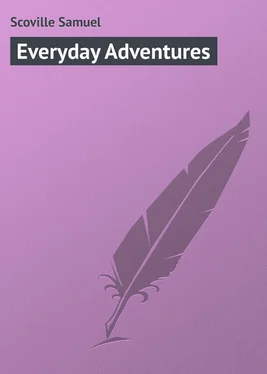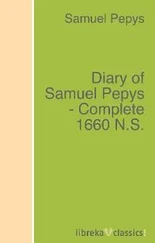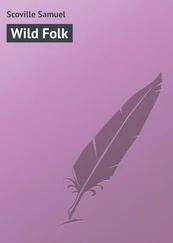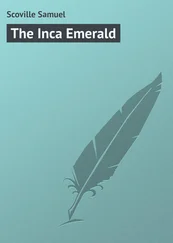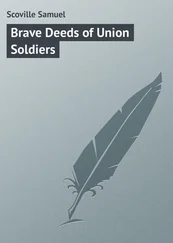Samuel Scoville - Everyday Adventures
Здесь есть возможность читать онлайн «Samuel Scoville - Everyday Adventures» — ознакомительный отрывок электронной книги совершенно бесплатно, а после прочтения отрывка купить полную версию. В некоторых случаях можно слушать аудио, скачать через торрент в формате fb2 и присутствует краткое содержание. Жанр: foreign_prose, foreign_language, на английском языке. Описание произведения, (предисловие) а так же отзывы посетителей доступны на портале библиотеки ЛибКат.
- Название:Everyday Adventures
- Автор:
- Жанр:
- Год:неизвестен
- ISBN:нет данных
- Рейтинг книги:3 / 5. Голосов: 1
-
Избранное:Добавить в избранное
- Отзывы:
-
Ваша оценка:
- 60
- 1
- 2
- 3
- 4
- 5
Everyday Adventures: краткое содержание, описание и аннотация
Предлагаем к чтению аннотацию, описание, краткое содержание или предисловие (зависит от того, что написал сам автор книги «Everyday Adventures»). Если вы не нашли необходимую информацию о книге — напишите в комментариях, мы постараемся отыскать её.
Everyday Adventures — читать онлайн ознакомительный отрывок
Ниже представлен текст книги, разбитый по страницам. Система сохранения места последней прочитанной страницы, позволяет с удобством читать онлайн бесплатно книгу «Everyday Adventures», без необходимости каждый раз заново искать на чём Вы остановились. Поставьте закладку, и сможете в любой момент перейти на страницу, на которой закончили чтение.
Интервал:
Закладка:
He lay so still that at first we thought he was dead; but on looking closely, we could see the quick throbbing of his frightened little heart. There was not a quiver from his taut body, or a blink from his wide-open eyes. He lay motionless until my hand stroked gently his wet fur. Then, indeed, he exploded like a brown bomb-shell from the snow, and we laughed and laughed, the first and last time for many a weary week.
Years later, I was coasting down the meadow-hill with one of my boys; and, as the sled came to a stop, a rabbit burst out of the snow, almost between the runners. The astonished boy rolled into a drift as if blown clear off his sled by the force of the explosion.
To-day, as the Brownie sped over the soft snow, we could see how its tracks in series of fours were made. At every jump the long hind-legs thrust themselves far in front. They made the two far-apart tracks in the snow, while the close-set fore-paws made the nearby tracks. Accordingly a rabbit is always traveling in the direction of the far-apart tracks, quite contrary to what most of us would suppose.
It is the same way with celestial rabbits. Look any clear winter night down below the belt of Orion, and you will see a great rabbit-track in the sky – the constellation of Lepus, the Hare, whose track leads away from the Great Dog with baleful Sirius gleaming green in his fell jaw.
From the rabbit-meadow we followed devious paths down through Fern Valley, which in summertime is a green mass of cinnamon fern, interrupted fern, Christmas fern, brake, regal fern, and half a score of others. In the midst of the marsh were rows of the fruit-stems of the sensitive fern, which is the first to blacken before the frost. These were heavy with rich wine-brown seed-pods, filled with seeds like fine dust. They had an oily, nutty taste; and it would seem as if some hungry mouse or bird would find them good eating during famine times. Yet so far as I have observed they are never fed upon.
Along the side of the path were thickets of spice-bush, whose crushed leaves in summer have an incense sweeter than burns in any censer of man’s making. To-day I broke one of the brittle branches, to nibble the perfumed bark, and found at the end of a twig, pretending to be a withered leaf, a cocoon of the prometheus moth. The leaf had been folded together, lined with spun silk, and lashed so strongly that the twig would break before the silken cable.
We passed through a clump of staghorn sumac with branches like antlers, bearing at their ends heavy masses of fruit-clusters made up of hundreds of dark, velvety crimson berries, each containing a brown seed. The pulp of these berries is intensely sour, its flavor giving the sumac its other name of “vinegar plant.” These red clusters crushed in sweetened water make a very good imitation of the red circus-lemonade of our childhood. The staghorn is not to be confounded with its treacherous sister, the poison sumac, with her corpse-colored berries. She is a vitriol-thrower, and with her death-pale bark and arsenic-green leaves, always makes me think of one of those haggard, horrible women of the Terror.
It was in Fern Valley that the Botanist made his discovery for the day. It was only a tree, and moreover a tree that he must have passed many times before. Only to-day, however, did it catch his eye. The bark was that of an oak, but the leaves, which clung thick and brown to the limb, were long, with a straight edge something like the leaves of the willow-oak, only broader and larger. It was no other than the laurel-oak, a tree which by all rights belonged hundreds of miles to the south of us.
He walked gloatingly around his discovery, and it was some time before I could drag him on. Thereafter he gave me a masterly discourse, some forty minutes in duration, on the life-history of the oaks, and propounded several ingenious theories to account for the presence of this strange species. This discourse continued until we reached the historic white oak near the end of the valley, where the Botanist once found a flock of bay-breasted warblers in the middle of a rainstorm; and again I heard the story of that day.
Through the valley flowed a little stream, and the snow along its banks told of the goings and comings of the wild-folk. Gray squirrels, red squirrels, muskrats, rabbits, mice, foxes, weasels, all had passed and repassed along these banks.
To me the most interesting trail was that of a blarina shrew. His track in the snow is a strange one. It is a round, tunnel-like trail, like that of some large caterpillar, with the trough made by the wallowing little body filled with tiny alternate tracks – one of the strangest of all the winter trails.
I could obtain very little enthusiasm from the Botanist over blarinas. He still babbled of laurel-leafed oaks and similar frivolities. Even the crowning event of the walk left him cold. It came on the home-stretch. We were passing through the last pasture before reaching the humdrum turnpike which led to the tame-folk. Suddenly in the snow I saw a strange trail. It was evidently made by a jumper, but not one whose track I knew. I followed it, until among the leaves in a bank something moved. Before my astonished eyes hopped falteringly, but bravely, a speckled toad.
The winter sun shone palely on his brown back still crusted with the earth of his chill home. Down under the leaves and the frozen ground he had heard the call, and struggled to the surface, expecting to find spring awaiting him. Two jumps, however, had landed him in a snowbank. It was a disillusion, and Mr. Toad winked his mild brown eyes piteously. He struggled bravely to get out, but every jump plunged him deeper into the snow. His movements became feebler as the little warmth his cold blood contained oozed out.
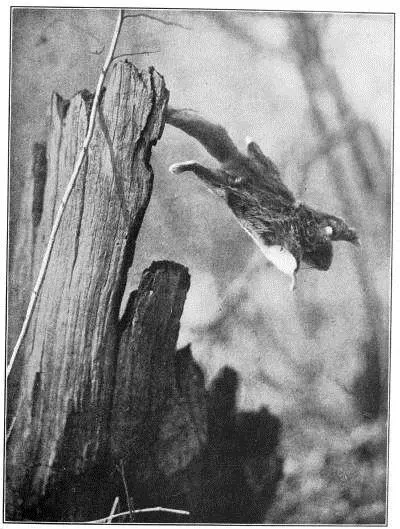
FLYER, THE SQUIRREL
Just as he was settling despairingly back into the crystallized cold, I rescued him. He was too far gone even to move, for cold spells quick death to the reptile folk. Only his blinking beautiful eyes, like lignite flecked with gold, and the slow throbbing of his mottled breast, showed that life was still in him. He nestled close in my hand, willing to occupy it until warm weather.
I back-tracked him from his faltering efforts, and where his first lusty jump showed on the thawing ground I found his hibernaculum. It was only a little hollow, scarcely three inches deep, under sodden leaves and wet earth, and cheerless enough, according to mammalian ideas. It was evidently home for Mr. Toad, and when I set him therein, he scrambled relievedly under some of the loose wet leaves which had fallen back into his nest. I piled a generous measure of dripping leaves and moist earth over his warted back. It may have been imagination, but I fancied that the last look I had from his bright eyes was one of gratitude. The Botanist scoffed at the
idea, for toads, like pine-snakes, convey absolutely no appeal to his narrow, flower-bound nature.
I have erected a monument in the shape of a chestnut stake beside Mr. Toad’s winter residence, and I strongly suspect that he will be the last of his family to get up when the spring rising-bell finally rings.
“There’s positively nothing to this early-rising business,” I can hear him telling his friends at the Puddle Club in April. “Look at what happened to me. If it hadn’t been for a well-meaning giant, I would have caught my death of cold from getting out of bed too soon. Never again!”
Our calendar-makers use red letters to mark special days. Personally, I prefer orchids and birds and sunrises and nests and snakes and similar markers. I have in my diary “The Day of the Prothonotary Warbler,” “The Day of the Henslow’s Sparrow’s Nest” (that was a day!), “The Day of the Fringed Gentian,” and many, many others. But always and forever that snowy 21st of December is marked in my memory as “The Day of the Early Toad.”
Читать дальшеИнтервал:
Закладка:
Похожие книги на «Everyday Adventures»
Представляем Вашему вниманию похожие книги на «Everyday Adventures» списком для выбора. Мы отобрали схожую по названию и смыслу литературу в надежде предоставить читателям больше вариантов отыскать новые, интересные, ещё непрочитанные произведения.
Обсуждение, отзывы о книге «Everyday Adventures» и просто собственные мнения читателей. Оставьте ваши комментарии, напишите, что Вы думаете о произведении, его смысле или главных героях. Укажите что конкретно понравилось, а что нет, и почему Вы так считаете.
